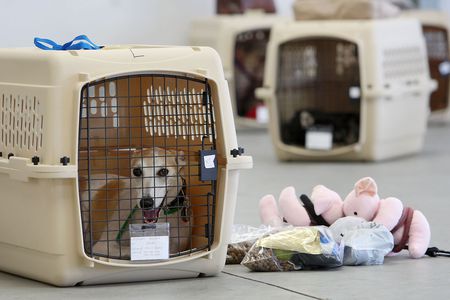Traveling internationally with your pet can be a fun and exciting experience for both you and your furry friend, but it also requires a lot of planning and preparation. The following are some tips to help you ensure a smooth and safe journey for your pet when traveling internationally:
- Check the pet import requirements for the country you are visiting: Different countries have different regulations regarding the importation of pets, so it’s important to research and comply with the specific requirements of your destination country. This may include obtaining a health certificate from your veterinarian, getting a rabies vaccination, or obtaining a special permit.
- Make travel arrangements for your pet: Depending on the country you are visiting and the size of your pet, you may need to make special arrangements for your pet to travel with you. For example, some airlines will only allow small pets to travel in the cabin with you, while larger pets may need to travel in the cargo hold. It’s important to check with the airline and make the necessary arrangements well in advance of your trip.
- Pack a travel kit for your pet: Just like you need to pack a bag when you travel, your pet will also need some essentials. Make sure to pack enough food and water for your pet, as well as any medications or special supplements that your pet may need. Don’t forget to bring along some familiar items, such as a favorite blanket or toy, to help your pet feel more comfortable during the trip.
- Keep your pet comfortable during the trip: Traveling can be stressful for pets, so it’s important to keep them as comfortable as possible. Keep them in a secure and well-ventilated carrier, and make sure they have enough room to move around. Consider bringing a familiar blanket or toy to help them feel more at ease.
- Be prepared for emergencies: No matter how well you plan, unexpected things can happen. Make sure you have contact information for a veterinarian in the area where you will be traveling and bring a copy of your pet’s medical records with you.
More Information in Detail
By following these tips, you can help ensure that your pet has a safe and comfortable journey when traveling internationally. Remember, it’s always best to consult with a veterinarian and the embassy of your destination country for the most accurate and current information.
Our pets are straight-up members of our family. We don’t want to leave them behind when we go on vacation, especially if we’re planning on being away from home for extended amounts of time. Plus, there are costs to consider when your pet is in someone else’s care. Overnight boarding fees vary and are dependent, in many cases, on the weight of your pet, whether or not you want a private room if you want enrichment toys and treats given to your dog each day and if you want your furry friend to have a daily walk for exercise.
If you’re lucky enough to have a friend or family member take care of your pet while you’re absent, you’ll have to consider the risks of your animal potentially destroying their property—chewing furniture, having in-house accidents, or damaging floors or doors with their nails. You’ll have to think about the grooming that might be necessary as well—will your dog need a haircut, and will his nails need to be trimmed while you’re gone? What happens if your pet gets sick, injured, or lost?
Sometimes, the easier choice might be to bring your pet with you when you travel. According to the U.S. Department of Transportation, more than 2 million pets and animals are transported by air every year in the states.1 Keep reading to learn what to consider before booking your flight.

Travel Internationally on an American Carrier
The U.S. Department of State advises pet owners to research and understand the intended airline carrier’s live pet guidelines and added charges before booking flights. You’ll need to decide if your pet is to fly in-cabin, as excess baggage, or as cargo. Also, be sure to check the travel policies directly before you book flights, as the terms are subject to change at any time. You’ll also need to review Transportation Security Administration’s (TSA) policies and contact them directly to verify before travel. The Overseas Briefing Center (OBC) suggests that owners request written approval of reservations made for their animal’s shipment.
Know the Three Ways to Travel with your Pet
When booking airfare, there are three ways to consider for shipping your pet.
- Your animal can travel with you, either in the cabin or in the cargo hold. These options both consider your pet as excess or accompanied baggage and will be charged as such. Not all airlines offer this as an option to passengers, and many have restrictions on which breeds can fly. In general, pets need to be less than 15 pounds, including the carrier’s weight, to travel in the cabin.
- Your pet may be booked on a separate flight, in which you will be charged the cargo rate, which is much higher than the first option. Also, some airlines do not offer this option.
- A licensed commercial shipper can be responsible for getting your pet from A to B. In this case, you will be responsible for the cargo rate and the shipper’s charge. Many airlines require this method for transportation unless your pet is compact enough to ride in the cabin.
Finally, some airlines don’t allow travel during certain parts of the year in the cargo hold due to weather. If it’s too hot or too cold, it may be necessary to reconsider travel. Your pet must also be able to stand, sit, and turn around in a sturdy carrier if being transported in cargo.

Flying with a Service Animal
As per the theme, you’ll need to check each airline to find out their exact policy at the time of travel, which can change at any time, to determine the specific airline’s rules and regulations. If your dog is registered as a service animal to assist a person with physical, sensory, psychiatric, intellectual, or other mental disability, she may legally fly with you in the cabin. Your rights, in this case, are protected under the Americans with Disabilities Act. You will have to follow the laws of foreign governments, however. Some countries require a mandatory animal quarantine period upon arrival, for example.
Service pets must be able to sit in the owner’s lap or on the floor below their seat in front of them. Animals must not obstruct the aisleway or sit in the emergency exit row. And, of course, animals must be trained and not bark, jump, or bite other passengers or airline employees.
Service Dog Registration of America suggests travelers check with the individual airline in person or over the phone to verify the exact policy and make sure everything is understood, especially when traveling internationally. A great resource for veterans who are interested in traveling internationally is America’s Vet Dogs.
Follow the International Animal Export Regulations
You’ll need to review the International Animal Export Regulations before international travel, provided by the U.S. Department of Agriculture—Animal Plant and Health Inspection Service (USDA-APHIS). It’s required that you connect with your vet to ensure that your pet is updated on vaccinations. Diagnostic testing or a health certificate may be obtained.
You’ll need to verify travel requirements with the countries you’ll be visiting—each country has its own set of export rules and requirements in addition to the airlines and shipping lines, which have their own policies for transporting pets. The USDA-APHIS has a great website for checking each country’s regulations. Australia, for example, requires USDA Accredited Veterinarian-collected blood samples. A laboratory submission form, completed by the USDA Veterinarian that drew the blood, must include the animal’s microchip details.
You’ll need to double-check the deadline for when to get a veterinarian examination and inoculations, which need to be done close to the departure date.
Call and Check in Advance
Be sure to call the airline directly before travel and speak with a person to determine the precise protocols. For American Airlines, call the reservation number at 1-800-433-7300 or the air cargo section at 1-800-227-4622. For Delta, call 1-800-241-4141 for reservations and 1-888-736-3738 for the live animal desk. And, for United Airlines, call 1-800-538-2929 for international reservations or 1-800-825-3788 for live cargo.
Things to Know Before You Go
Travel is stressful for humans, but even more so for pets. Make sure your animal is comfortable with its carrier before your flight. Consider spending more money on fewer flights to avoid connections or layovers. Do not travel with pets in cargo if it’s extremely hot or cold outside (perhaps nighttime travel is better in the summer, and daytime is better in the winter). Exercise your pet before boarding and immediately after deplaning.
The Federal Animal Welfare Act requires that dogs and cats be eight weeks or older, and must be weaned from their mothers for at least five days. Crates must meet certain standards for size, ventilation, and sanitation. Food and water must be provided to animals traveling more than 12 hours. Animals must be comfortable and not exposed to temperatures less than 45 degrees Fahrenheit.
Be Prepared for an Emergency
Of course, traveling with your pet has inherent risks. You may have planned for every scenario. However, pets sometimes get sick, and some even die on airplanes. First and foremost, you should determine if your pet is healthy and young enough to travel internationally. If there are any doubts, you should reconsider international travel with your animal. Your woolly pal should be able to handle a long flight in a pet carrier or cargo hold with ease and relative comfort.
Tips for Traveling Internationally with Your Pet
- To dot the i’s and cross the t’s, make sure you have copies of your pet’s documents when traveling internationally and for the return flight home—you may want to make an extra copy that you store in a separate location, just to be safe.
- You’ll need to start the whole process early and give yourself plenty of time to gather the proper paperwork and take care of your pet’s required veterinarian care.
- Your veterinarian will be a great resource for you as you plan for your trip—the doctor will help you determine what blood tests, vaccinations, and microchips might be necessary before travel.
5 Big Reasons To Opt For Pet-friendly Vacations
Frequently Asked Questions About How to Travel Internationally With Your Pet
Q. Can I bring my pet with me to the cabin on an international flight?
A – It depends on the airline and the size of your pet. Many airlines have restrictions on the size and type of pet that can travel in the cabin, and may only allow small pets in a carrier under the seat. It’s important to check with the airline well in advance of your trip to make sure your pet meets its requirements and to make the necessary arrangements.
Q. What documents do I need to bring my pet internationally?
A – The documents required will vary depending on the country you are visiting. In general, you will need a health certificate from your veterinarian, proof of rabies vaccination, and possibly a permit or other documentation. It is important to check with the embassy of your destination country for the most up-to-date information.
Q. Can I give my pet sedatives during the flight?
A – It’s not recommended to give your pet sedatives during the flight, as it can be dangerous for them. Consult with your veterinarian for advice on how best to keep your pet comfortable during the flight.
Q. How should I prepare my pet for the flight?
A – To prepare your pet for the flight, try to acclimate them to the carrier well in advance. You can do this by leaving the carrier out in a familiar area with treats and toys inside, allowing them to get used to it. Also, make sure your pet is up to date on vaccinations and check with your veterinarian if they have any health concerns.
Q. What should I do if my pet gets lost while traveling internationally?
A – If your pet gets lost while traveling internationally, contact your local embassy or consulate immediately. They may be able to help you locate your pet or provide you with resources for doing so. It’s also a good idea to make sure your pet is microchipped and has identification tags on its collar with contact information.









